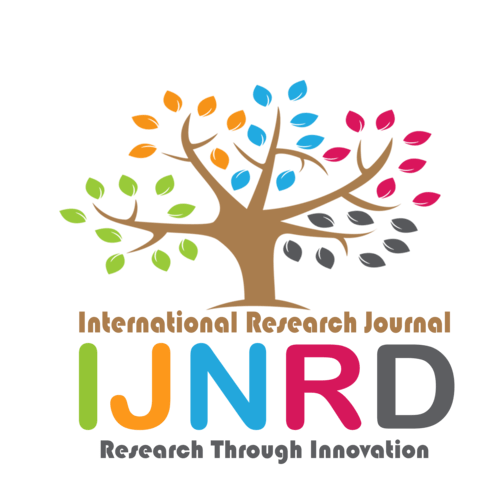|
|||||||||||||||

|
INTERNATIONAL JOURNAL OF NOVEL RESEARCH AND DEVELOPMENT International Peer Reviewed & Refereed Journals, Open Access Journal ISSN Approved Journal No: 2456-4184 | Impact factor: 8.76 | ESTD Year: 2016 Scholarly open access journals, Peer-reviewed, and Refereed Journals, Impact factor 8.76 (Calculate by google scholar and Semantic Scholar | AI-Powered Research Tool) , Multidisciplinary, Monthly, Indexing in all major database & Metadata, Citation Generator, Digital Object Identifier(DOI) |
||||||||||||||
Issue: April 2024
Volume 9 | Issue 4
Review Result and Publication of Paper within : 2-3 days
Click Here For more DetailsFor Authors
Forms / Download
Published Issue Details
Editorial Board
Other IMP Links
Facts & Figure
Impact Factor : 8.76
Issue per Year : 12
Volume Published : 9
Issue Published : 95
Article Submitted :
Article Published :
Total Authors :
Total Reviewer :
Total Countries :
Indexing Partner
Join RMS/Earn 300
Licence
This work is licensed under a Creative Commons Attribution-NonCommercial 4.0 International License







|
Published Paper Details
|
|
| Paper Title: | AN ASSESSMENT OF THE EFFECT OF ENERGY MIX ON ENERGY DEFICIT IN ZAMBIA: A CASE STUDY OF 10 MILES IN CHIBOMBO DISTRICT. |
| Authors Name: | RODGERS PHIRI , Dr. KASONDE MUNDENDE |
| Download E-Certificate: | Download |
| Author Reg. ID: |
IJNRD_191779
|
| Published Paper Id: | IJNRD2306154 |
| Published In: | Volume 8 Issue 6, June-2023 |
| DOI: | |
| Abstract: | This abstract is based on the study conducted in 10miles of chibombo district of central province. 10 miles experiences energy deficit just like many parts of Zambia. Zambia largely depends on hydroelectricity but hydropower has a fatal flaw. Drought has lowered water levels to the point where power production is severely curtailed. Droughts in recent years have produced electricity shortages estimated at nearly one-third of Zambia’s total installed hydroelectric capacity of 2,380 megawatts. Despite these studies, little attention, if any, has been paid to the effect of the mix of different energy technologies on energy deficit in the study area. The extent of the effect of energy mix on its accessibility and availability at 10miles was not known to the researcher. This created a problem worth investigating. Previous studies such as Kaela’s (2018) predicted the energy mix levels of Zambia by the year 2050 but did not discuss the extent of its effect on its accessibility and availability in the study area, the gap this study wished to assess. If the extent of the energy mix on energy deficit was not investigated, 10 miles area would have continued exploiting detrimental activities such as charcoal production. The aim of the study was to determine the influence of energy mix on energy deficit in 10 Miles, Chibombo District, which was achieved through the following objectives: to ascertain types of energy used at 10 miles, to establish the drivers of types of energy used at 10 miles and to explore the effects of energy mix on energy deficit at 10 miles. The energy mix in 10 miles can have a significant impact on the energy deficit. Over-reliance on traditional biomass fuels and fossil fuels may contribute to environmental degradation, health issues, and energy insecurity, while diversifying the energy mix with renewable energy sources can provide a sustainable and clean solution to meet the energy demand and reduce the energy deficit in the long term. Planning and implementing a balanced and sustainable energy mix that considers the availability, reliability, affordability, and environmental impacts of different energy sources can play a crucial role in addressing the energy deficit in 10 miles. So, it is essential to carefully assess and plan the energy mix to ensure energy security, sustainability, and resilience in 10 miles. Additionally, proper policies and interventions may be needed to promote renewable energy adoption, improve energy efficiency, and address socio-economic and environmental challenges associated with energy deficit in 10 miles. This could include initiatives such as promoting the use of clean cooking stoves, investing in renewable energy infrastructure, improving energy access in rural areas, and raising awareness about sustainable energy practices among local communities. Furthermore, engaging local stakeholders, including communities, businesses, and government agencies, in decision-making processes related to energy mix and energy deficit can help ensure that the energy mix is enabled. |
| Keywords: | |
| Cite Article: | "AN ASSESSMENT OF THE EFFECT OF ENERGY MIX ON ENERGY DEFICIT IN ZAMBIA: A CASE STUDY OF 10 MILES IN CHIBOMBO DISTRICT.", International Journal of Novel Research and Development (www.ijnrd.org), ISSN:2456-4184, Vol.8, Issue 6, page no.b477-b493, June-2023, Available :http://www.ijnrd.org/papers/IJNRD2306154.pdf |
| Downloads: | 000118764 |
| ISSN: |
2456-4184 | IMPACT FACTOR: 8.76 Calculated By Google Scholar| ESTD YEAR: 2016 An International Scholarly Open Access Journal, Peer-Reviewed, Refereed Journal Impact Factor 8.76 Calculate by Google Scholar and Semantic Scholar | AI-Powered Research Tool, Multidisciplinary, Monthly, Multilanguage Journal Indexing in All Major Database & Metadata, Citation Generator |
| Publication Details: |
Published Paper ID:IJNRD2306154 Registration ID: 191779 Published In: Volume 8 Issue 6, June-2023 DOI (Digital Object Identifier): Page No: b477-b493 Country: Lusaka, Zambia, Zambia Research Area: Environmental Management Publisher : IJ Publication Published Paper URL : https://www.ijnrd.org/viewpaperforall?paper=IJNRD2306154 Published Paper PDF: https://www.ijnrd.org/papers/IJNRD2306154 |
| Share Article: | |
|
Click Here to Download This Article |
|
| Article Preview | |
|
|
|
Major Indexing from www.ijnrd.org
| Semantic Scholar | Microsaoft Academic | ORCID | Zenodo |
| Google Scholar | ResearcherID Thomson Reuters | Mendeley : reference manager | Academia.edu |
| arXiv.org : cornell university library | Research Gate | CiteSeerX | PUBLON |
| DRJI | SSRN | Scribd | DocStoc |
ISSN Details
 |
 |
ISSN: 2456-4184
Impact Factor: 8.76 and ISSN APPROVED
Journal Starting Year (ESTD) : 2016
DOI (A digital object identifier)
Conference
Open Access License Policy
Important Details
Social Media
| Copyright © 2024 - All Rights Reserved - IJNRD |












Facebook Twitter Instagram LinkedIn